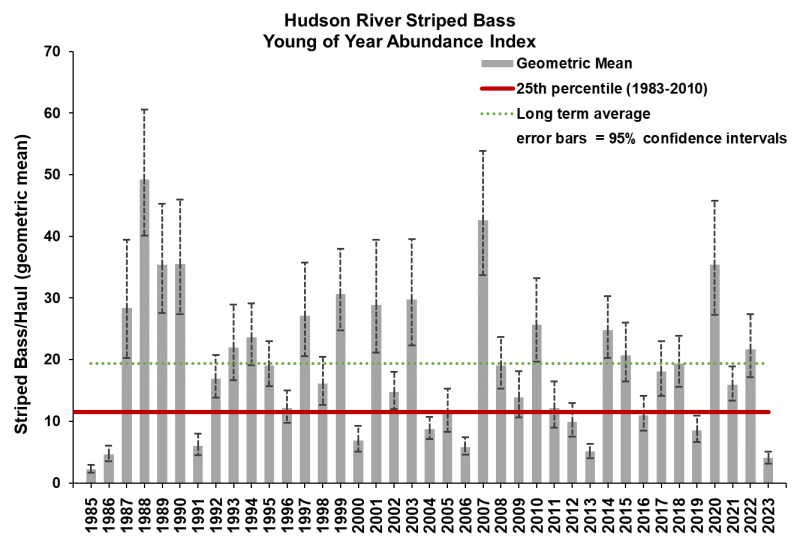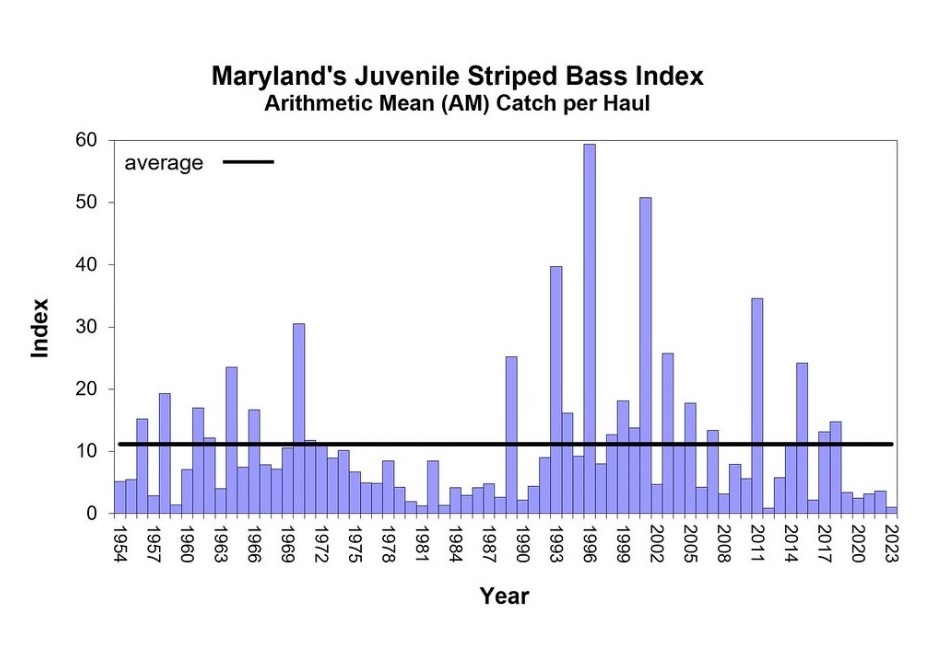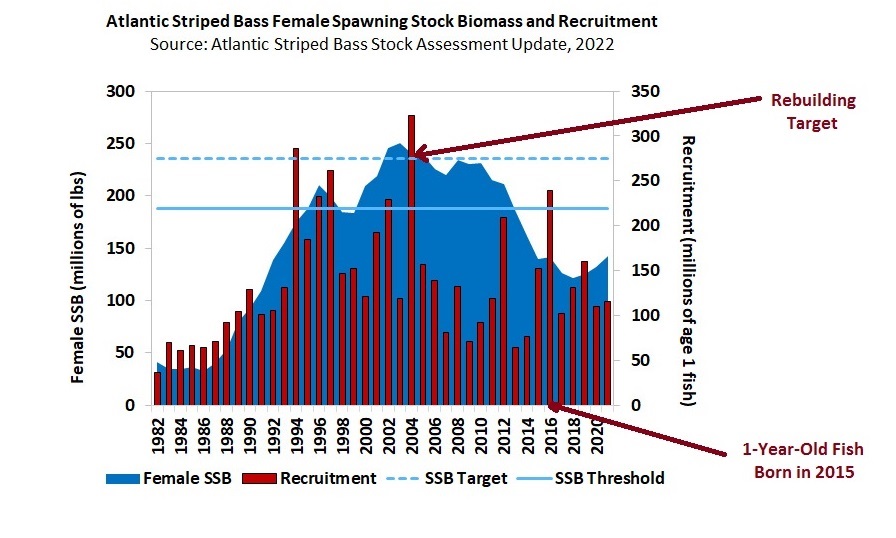After some pretty dismal news came out of the Chesapeake last fall from Maryland’s juvenile striped bass survey, many folks had been hoping that the Hudson River young-of-the-year (YOY) surveys would show improved spawning in 2023 to help fill in some gaps in the stock.
Last week we learned that those “gaps” are only getting bigger.
According to the latest update from the New York Department of Environmental Conservation (NYDEC), the 2023 YOY abundance index – a geometric mean number of striped bass per haul through weeks 29-45 for striped bass collected in the Hudson River – appears to have come in at a near all-time low.

In fact, according to the NYDEC chart, the 2023 index is significantly below the long-term average, indicating that last year may go down in the history books as one of the worst recruitment seasons for striped bass since the 1980s.
NYDEC’s Hudson River striped bass YOY index value provides an estimate of annual recruitment for striped bass in the Hudson River. This index is generated through a beach seine survey at 13 sites along the lower Hudson River conducted bi-weekly from July to November. In addition to the Hudson River seining efforts, NYDEC also collects striped bass data in the Western Long Island (WLI) survey. This survey captures predominantly 1-year-old fish and is used in striped bass stock assessments.
NYDEC sources confirmed the posted numbers to The Fisherman on Sunday while at the Striper Day event on Long Island, but otherwise had no comment.
Regrettably, the latest results from the Hudson River analysis track pretty closely with similar surveys coming out of Maryland, Virginia and New Jersey, which when combined together should produce fairly poor recruitment numbers across the board in the striped bass fishery for 2023.
Last fall, the Maryland Department of Natural Resources (DNR) announced the results of their 2023 juvenile striped bass survey, tracking the reproductive success of stripers in the Chesapeake Bay, the 2023 YOY index registered at a dismal 1.0, which DNR said is well below the long-term average of 11.1.
According to DNR, striped bass spawning activity is temperature-driven and historically adult fish migrated to the Chesapeake Bay to spawn in April and May, which aligned with the seasonal arrival of zooplankton and other microscopic food sources that larval striped bass eat. However, recent winters have produced lower-than-average snowfalls in the region and therefore there has been less snowmelt to cool the rivers and streams where striped bass spawn. Research has also shown spring zooplankton production in the Bay is being altered by warmer winters.
“The warm, dry conditions in winter and spring during the past several years have not been conducive to the successful reproduction of fish that migrate to fresh water for spawning,” said DNR’s Fisheries and Boating Director Lynn Fegley.
Preliminary results from an ongoing long-term survey of striped bass recruitment conducted by researchers at the Virginia Institute of Marine Science (VIMS) also suggest a poor year class of young-of-year striped bass was produced in Virginia tributaries of the Chesapeake Bay in 2023. The 2023 year class represents the group of fish hatched this spring that will grow to fishable sizes in 3 to 4 years.

The VIMS Juvenile Striped Bass Seine Survey recorded a mean value of 4.26 fish per haul in the Virginia portion of the Chesapeake Bay; this value is called a recruitment index by scientists. The 2023 value is significantly lower than the historic average of 7.77 fish per seine haul and is a notable decrease in annual recruitment compared with recent years in which catches of striped bass were rated average or above average.
The New Jersey Department of Environmental Protection (NJDEP) also announced the results of its 2023 YOY index sampling on the Delaware River, showing a mean catch per unit of effort (CPUE) of 0.232 which ranks 38th out of 43 years of sampling there. NJDEP utilizes a 100-foot bagged seine to compile samples from three different regions of the Delaware River at 287 different stations. A total of 314 striped bass were sampled from the Delaware during the June through October sampling period, with 220 of those fish (70%) making up young-of-the-year specimens.
In May of 2023, the Atlantic States Marine Fisheries Commission (ASMFC) implemented an emergency measure that prohibits anglers from harvesting fish larger than 31 inches, a step taken to better protect large fish, and particularly the striped bass born in 2015 which represent the best YOY class in 20 years. The commission will hold their annual Winter Meeting from January 23-25, 2024 in Arlington, VA, with the ASMFC’s Atlantic Striped Bass Management Board convening on Wednesday the 24th from 1:45 p.m. until 4:45 p.m. to consider new striped bass management efforts through Draft Addendum II.
You can expect that the final striped bass YOY and recruitment numbers tallied through 2023 will be a major part of the management discussion.
Fishery scientists are continuing to investigate whether higher temperatures earlier in the year are affecting the survivability of juvenile striped bass, and according to Maryland’s DNR other anadromous species with similar spawning behavior such as white perch, yellow perch, and herring are also experienced below-average reproduction on the Chesapeake in 2023.
“It’s important to remember that increasing the size of the striped bass stock does not guarantee strong reproduction,” said Fegley. “We will continue to work with other coastal states to rebuild the population so spawning can succeed when conditions are right.”


